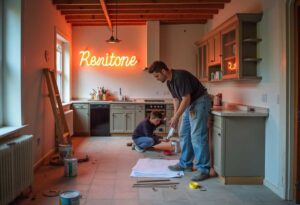A basement is more than just a place to store holiday decorations and old furniture — it’s untapped potential sitting right beneath your feet. Finishing your basement can not only increase your living space but also raise your property’s value, improve energy efficiency, and open the door to exciting possibilities like a home theater, rental suite, gym, or workspace.
In this article, we’ll walk you through everything you need to know about basement finishing — from planning and permits to design ideas, common challenges, cost-saving strategies, and pro-level tips. Whether you’re a homeowner seeking more livable square footage or a property investor looking to boost ROI, this guide will help you approach basement finishing the right way — with confidence, clarity, and creativity.
The Hidden Potential of a Basement
When most people think of a basement, they imagine dark corners, exposed pipes, or an unfinished space used for storage. But with the right vision and planning, that underutilized square footage can become the most loved part of your home. Whether you’re dealing with a full-height basement or a compact nook, transforming it into a livable area allows you to expand your home without the cost of an addition.
Design Potential Highlights:
- Cozy guest suite or Airbnb rental
- Dedicated home office or gym
- Playroom for kids or a private lounge
- Multimedia room or recording studio
- Wine cellar or home spa
The key is thinking beyond the basement’s current limitations and reimagining it as a lifestyle upgrade.
Setting Your Vision: Living Room, Office, or Suite?
Before knocking down walls or shopping for flooring, clarity is key. What do you want your basement to be? And more importantly, who will use it?
Start with a few questions:
- Will this space serve family, guests, or tenants?
- Is it meant for quiet focus or entertaining crowds?
- Do you want open concept or defined zones?
Popular Finished Basement Ideas:
- Media Room: With soundproofing and dimmable lighting
- In-Law Suite: With a private bathroom and kitchenette
- Work-from-Home Office: Quiet, distraction-free workspace
- Teen Lounge: Gaming area, couch pit, and snack zone
- Hybrid Space: Office by day, guest room by night
Once your goals are defined, you can reverse-engineer the entire design around function and lifestyle.
Modern Basement Design Trends in 2025
2025 basement trends are blending smart design with cozy sophistication. Forget dated paneling and fluorescent bulbs — today’s finished basements are as stylish as any other level of the house.
Top Trends to Watch:
- Floating furniture layouts to create fluid movement
- Industrial-meets-warm lighting with matte black fixtures
- Concrete-look flooring combined with soft textures
- Accent walls using fluted wood, bold paint, or 3D tiles
- Smart home integrations (hidden speakers, app-controlled lighting, security cams)
Basement design is finally catching up to the main floor — and in many cases, surpassing it.
Color Palettes That Open Up Spaces
Color can make or break a basement’s feel. With limited natural light, the goal is to brighten without washing out, cozy up without closing in.
Winning Color Strategies:
- Soft Neutrals: Light grays, warm beiges, creamy whites
- Pale Blues & Greens: Reflective and refreshing
- Two-Tone Walls: Upper light / lower deep for balance
- Strategic Accent Colors: Terracotta, navy, sage for warmth
Avoid stark whites (which look clinical in low light) and heavy darks (which can overwhelm unless balanced with great lighting).
Pro Tip: Paint ceilings the same tone as walls for a seamless, spacious feel — especially if you’re dealing with lower headroom.
Flooring and Wall Finishes That Impress
Basements require finishes that are not just stylish — they must also resist moisture, reduce echo, and feel great underfoot.
Recommended Flooring Options:
- Luxury Vinyl Plank (LVP): Waterproof, realistic, and soft underfoot
- Sealed Concrete: Modern industrial with rugs layered in
- Engineered Hardwood: Works if moisture is fully controlled
- Cork or Rubber Tiles: Sustainable and soft for rec rooms or gyms
Wall Finish Ideas:
- Painted drywall with decorative trim
- Shiplap or fluted wood panels
- Faux brick or stone veneer for rustic themes
- Fabric panels for acoustic dampening
Combine practical materials with eye-catching finishes, and you’ll never feel like you’re “in a basement” again.
Clever Layouts for Small Basements
Working with limited square footage doesn’t mean you have to sacrifice comfort or style. The smartest basement layouts are function-driven, use flexible zones, and rely on visual separation instead of walls.
Top Layout Tips for Tight Basements:
- Multifunctional zones: Combine workspace and guest space with a murphy bed or fold-out desk.
- Built-in storage: Think under-stair drawers, wall-mounted shelving, and recessed nooks.
- Sliding barn doors or curtains: Save space and define private areas without swinging doors.
- Split layouts: Divide the basement into two main functions (e.g., gym and lounge) using rugs or lighting.
Design Tip: Stick to open corners and floating furniture. Clutter makes a small space feel even smaller.
Open Concept vs. Zoned Spaces
Open concept layouts create a feeling of spaciousness, especially in basements that lack windows. But zoning can make a large space feel cozier, more purposeful, and less like a hall.
Pros of Open Concept:
- Light flows better across rooms
- Great for entertaining or family hangouts
- Easy to reconfigure over time
When to Use Zoned Layouts:
- You need quiet work/study areas
- You’re building a legal suite or rental unit
- You want to create a sense of intimacy or privacy
Smart Compromise? Use half walls, bookshelves, or changes in flooring texture to subtly define zones without cutting off space.
Creating Natural Light Illusions
Basements naturally lack sunlight — but that doesn’t mean they have to feel like caves. With a few tricks, you can create the illusion of light, even if your windows are tiny or nonexistent.
Light-Enhancing Techniques:
- Mirrors: Place them strategically to reflect artificial light and double visual space.
- Glossy paint finishes: Bounce light around, especially in small rooms.
- Uplighting and wall sconces: Light flows up instead of down, simulating daylight.
- Faux windows or lightboxes: Backlit panels that mimic the look of a sunny view.
- Glass-paneled doors: Allow natural light to leak through from stairwells or upstairs.
Pro Tip: Use daylight-temperature LED bulbs (5000K–6500K) for a bright, crisp atmosphere.
Home Theaters, Gyms, and Game Rooms
If you’ve always dreamed of your own private entertainment space, the basement is the ultimate place to build it. Why? It’s sound-insulated, out of the way, and can be customized without affecting your main living area.
Basement Entertainment Zones:
- Home Theater: Soundproof drywall, projector setup, and tiered seating
- Fitness Studio: Rubber flooring, mirrors, compact weight racks, and ventilation fans
- Game Room: Dartboard, pool table, arcade machine, or console setup
Mix and match based on your lifestyle — a gym in the morning and a movie lounge at night? Totally doable with good zoning.
Adding a Bathroom or Wet Bar
Adding plumbing to a basement instantly increases its livability and value. Whether you’re building a guest suite or just want convenience during movie marathons, a bathroom or wet bar is a must-have.
Basement Bathroom Design Tips:
- Use corner sinks and sliding doors for space-saving
- Choose moisture-resistant flooring (LVP, porcelain tile)
- Add small horizontal windows for light + privacy
Wet Bar Essentials:
- Mini fridge and compact sink
- Open shelving or wine rack
- LED strip lighting for a sleek vibe
- Butcher block or quartz counters for easy cleanup
Code Reminder: Ensure plumbing is up to local code — especially if you’re adding drainage or wastewater lines.
Basement Kitchens and Rental Units
Turning a basement into a fully functional living space with a kitchenette or full kitchen opens the door to long-term rentals, Airbnb income, or multigenerational living. But execution is everything.
Kitchen Design for Basements:
- Compact appliances: 24-inch stoves, under-counter fridges
- Open shelving: Reduces visual bulk in low ceilings
- Moisture-tolerant materials: Think quartz countertops and ceramic backsplashes
- Proper ventilation: Essential to avoid lingering smells and humidity buildup
If you’re building a legal rental unit, don’t forget:
- A separate entrance and egress window
- Zoning approval and fire code compliance
- Sound insulation between floors
This is where a finished basement shifts from lifestyle enhancement to revenue generation.
Space Optimization for Families
A finished basement can take pressure off your upstairs living space — especially for growing families. Done right, it becomes a quiet retreat, a kids’ kingdom, or a study-friendly hideout.
Kid & Family-Friendly Features:
- Chalkboard walls or magnet boards
- Toy cubbies and low seating
- Wall-mounted desks for homework stations
- Heated flooring to make playtime more inviting
- Hidden storage beneath benches or stairs
Basements give families the room to spread out without feeling disconnected.
How to Add Personality Without Clutter
A finished basement doesn’t have to feel sterile — or overstuffed. A few intentional choices go a long way in creating warmth and character without chaos.
Design Moves That Add Personality:
- One bold feature wall: A mural, wallpaper, or textured paneling
- Layered lighting: Sconces, task lamps, and LED strip accents
- Gallery walls or floating bookshelves
- Rugs and textiles to soften hard surfaces
Avoid this: Over-decorating with small furniture or heavy decor. Basements need airiness to counteract their naturally closed-in feel.
Eco-Friendly Material Choices
Sustainability isn’t just for the main floors. Eco-conscious design choices in your basement finishing plan help reduce environmental impact and future-proof your space.
Green Basement Ideas:
- Reclaimed wood or bamboo floors
- Low-VOC paints and adhesives
- Insulated subfloor panels that minimize energy loss
- LED lighting with motion sensors
- Natural wool rugs instead of synthetics
Not only do these choices protect your air quality, but they also support better resale value as green renovations become buyer priorities.
Final Styling and Decor Touches
Your basement should feel intentional and inviting — not like an afterthought. Once the structure is done, invest time in styling it with the same care as your main living spaces.
Finishing Touches Checklist:
- Curtains and textiles: Add softness and absorb sound
- Plants and greenery: Bring life to the space (try faux if natural light is low)
- Personal artifacts: Family photos, travel souvenirs, or heirlooms
- Cohesive color palette: Carry through with paint, rugs, and furniture tones
Every detail contributes to transforming a basement from “extra space” to “favorite room in the house.”
Conclusion: A Smart Move with Serious Impact
Finishing your basement isn’t just about more space — it’s about transforming the way you live. Whether you want a cozy den, an income-generating suite, or simply a flexible family space, the basement offers a blank slate with massive potential.
Approach the project with smart planning, high-quality materials, and a clear vision — and you’ll gain not just square footage, but style, value, and function your whole home can benefit from.
Frequently Asked Questions (FAQs)
How much does it cost to finish a basement?
Costs vary by size and location, but you can expect to spend $25–$50 per square foot on average. Luxury finishes, bathrooms, or kitchens will increase the total.
Do I need a permit to finish my basement?
Yes — most municipalities require permits for electrical, plumbing, and structural work. Always check local building codes before starting.
What kind of flooring is best for a basement?
Luxury Vinyl Plank (LVP) is ideal due to its water resistance and comfort. Sealed concrete, tile, or engineered hardwood are also great if properly moisture-proofed..
Can I add a bedroom in the basement legally?
Only if there is a proper egress window or door for emergency exit. Always confirm your layout meets fire code regulations.
How long does it take to finish a basement?
On average, expect 6–12 weeks depending on size, complexity, and whether you’re hiring contractors or DIYing.





